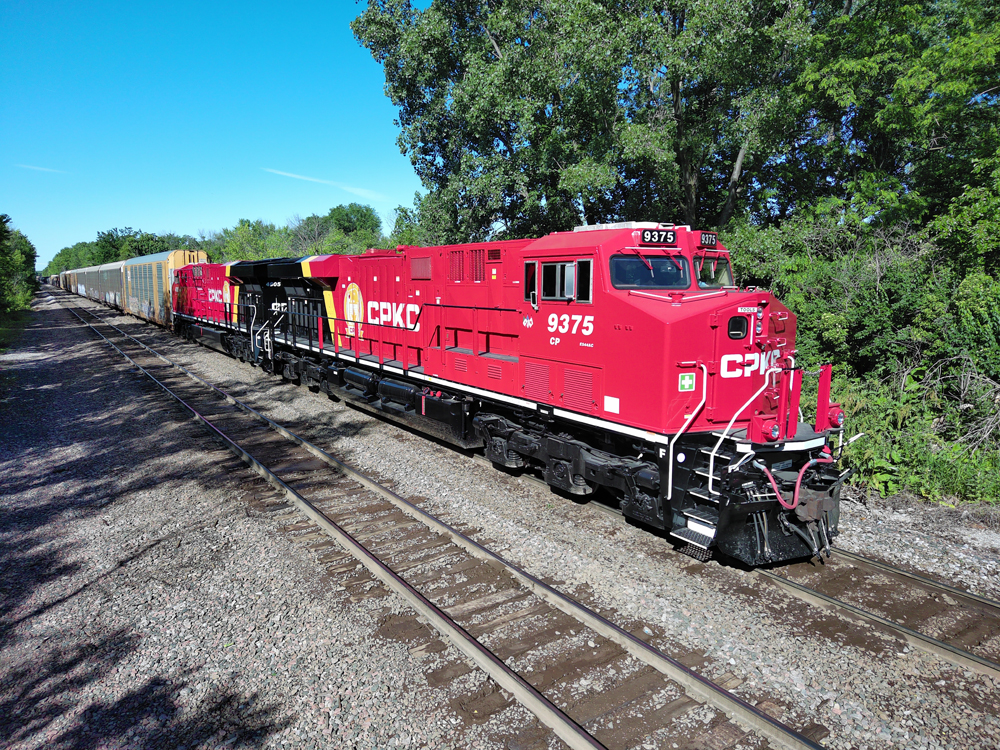
CALGARY, Alberta — Canadian Pacific Kansas City had a gangbuster second quarter as merger-related traffic synergies kicked in faster than expected and boosted revenue and profits, executives said on Tuesday.
Although freight demand remains soft, CPKC has been able to create its own opportunities thanks to last year’s combination of Canadian Pacific and Kansas City Southern, CEO Keith Creel says. “I’m extremely pleased with the first half of the year,” he told investors and analysts on the railway’s earnings call Tuesday afternoon.
CPKC’s quarterly operating income — adjusted to reflect the April 14, 2023, CP-KCS merger as if it occurred on Jan. 1 — increased 17%, to $1.37 billion, as adjusted revenue grew 8%, to $3.6 billion. Adjusted earnings per share increased 27%, to $1.05. The combined railway’s operating ratio improved 2.8 points, to 61.8%.
Quarterly volume decreased 4% when measured by carloads, but increased 6% when measured by revenue ton-miles, CPKC’s preferred metric.
The gap between carloads and RTMs, Creel says, can be explained by the loss of short-haul, cross-border intermodal traffic at the end of 2023. That’s when BNSF Railway and J.B. Hunt shifted their Mexico traffic away from CPKC and the Laredo gateway to Eagle Pass, Texas, and a connection with Ferromex.
The annual low-margin, short-haul volume that was lost totals about 170,000 containers. “RTMs should be the holy grail when it comes to this railroad, not carloads,” Creel says.
The dynamic also shows up in CPKC’s average length of haul. It was up 6% overall in the second quarter, Chief Marketing Officer John Brooks says, but domestic intermodal length of haul increased by double digits.
CPKC also enjoyed longer hauls on energy, chemicals, and plastics traffic moving in single-line service between Canada, the U.S. Gulf Coast, and Mexico, Brooks says. As a result, energy, chemicals, and plastics revenue ton-miles grew 14% in the quarter.
Automotive RTMs increased 21% in the quarter thanks to longer hauls from Mexican assembly plants to destinations in the U.S. and Canada. And CPKC’s Mexico Midwest Express premium intermodal service, carried on trains 180/181, grew by 50%.
“An area that we didn’t expect to be as strong at this point was some of our grain into Mexico,” Brooks says. In July, CPKC operated 15 grain trains from legacy CP origins to destinations in Mexico, compared to nine in June, and six in May. “We’re seeing a nice ramp up in that bulk franchise,” Brooks says.
International intermodal volume declined 9% as shippers diverted some traffic in anticipation of a potential Canadian rail strike. The loss of an international intermodal contract also dented volumes.
CPKC’s key operating metrics improved during the quarter, with average train speed up 6% and terminal dwell down by 9%. The railway’s train accident rate improved 4%, while the personal injury rate improved 38%.














This is good…but it’s what one would expect after an end-to-end combination: longer hauls. It is a good first step but there needs to be more. Logistics is a chain of links. The more links you own or control the better the result.
Revenue ton miles is a much more precise measurement. Example: So, -CP has traded 5 – 500 mile loads for 1 4000 mile revenue load. Even if loads have decreased total TMs better. Why hasn’t STB required that? Much better measurement of overall. Another example off topic is Amtrak’s measurement of Riders not revenue passenger miles.
What would be interesting to know [and perhaps difficult to determine] is the extent that CPKC’s growth is new, shifting from road, or pirated from other carriers.
Probably auto parts and MMX had the most impact on trucks, but I agree, they don’t say.
Notice the careful wording on grain movements with “legacy CP origins” to stay away from the UP lawsuit.
Cat and mouse wordsmith.